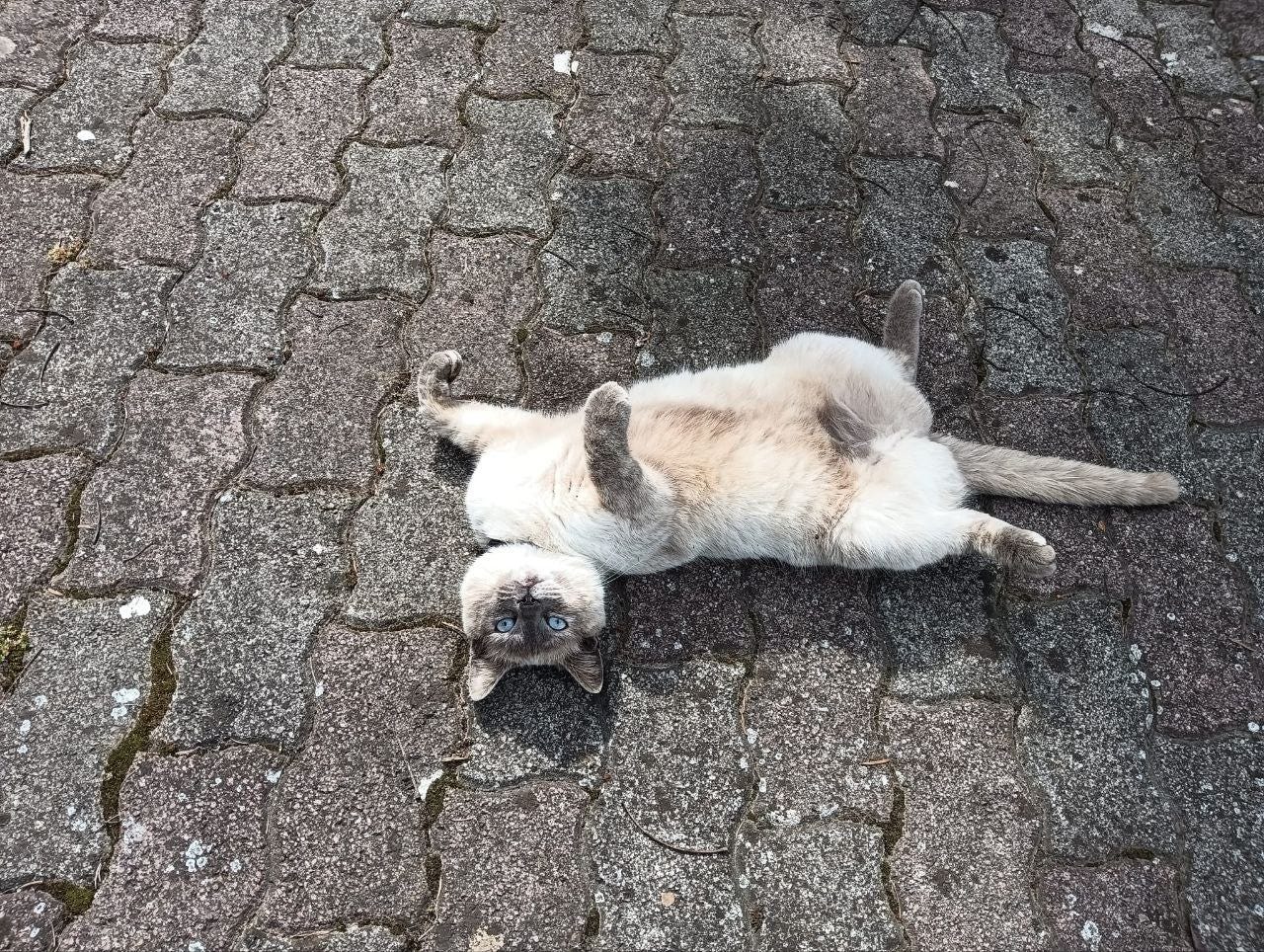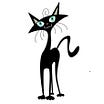Weekly newsletter - The magic of words: Special Guest
The Meow-ning of Words: When Linguistics Gets Fur-Midable!
Admit it: you love watching cat videos on the Internet. No matter your age, background, or interests, no matter how serious you are, I’m sure you’ve chuckled at a cat video at least once.
But what if I told you cat-related Internet is a thing? And if you’re there, feeling guilty about procrastinating your next Substack post, just know that watching cat videos can help relieve feelings of guilt due to perceived unproductivity. It’s like our brains saying, “Hey, that is a good reason not to be doing stuff!”
But isn’t my newsletter supposed to be about words and languages? Well, worry not, because I’m onto something here. Or better said, my friend
definitely is!After getting familiar with the work of another linguist,
in this post, please, be introduced to the brilliant mind who brought together two of my favourite things in life and online: language and cats.Cats are amazing and awesome – or actually “ameowzing” and “pawsome” to put it correctly when we are talking about cats online. And because cats and the internet are connected and we are online now, let’s talk about cats. Many people have an online account for their cats and/or post cat pictures online. I noticed that people pretended to be their cats. And as cats, they used their own kind of language with their own words and their own spellings. As a dialectologist, I went “yes!” straight away because I had found a new dialect to explore: a purriety (a purr variety) of language.
If you’ve ever come across cat memes - who hasn’t? - I’m sure you know what she’s talking about: expressions like “If it fits, I sits” or intentionally misspelled words like “smol” or “purr-fect” are examples of Internet cat slang.
And who’s better equipped to explore and study a purr variety of language than a linguist with a PhD in dialectology?
Wait, what exactly does that mean, by the way?
I am a sociolinguist with a specialisation in regional dialects of English. For my PhD I looked at the accent of English as it is used in South Wales, UK. Basically I described how people in Neath, a town in South Wales, speak and pronounce the words. And I looked at what difference age, education, and gender make in how people speak. To sum up all those years of studying in one sentence, the factors age, education, and gender all have an influence on how people speak and Neath English is a typical Southern Welsh English dialect.
I’m not sure what the “typical” research topics of sociolinguists are, but I’d bet your interest in cats makes you research particularly interesting and approachable even for those outside your specialist area. Is this something you’ve intentionally meant to do or just a pleasant byproduct?
Online cats are fun, and linguistics is fun – at least for me. And now I am researching online cats in connection with linguistics, and I wanted to write about that. Taking a non-serious subject and looking at it scientifically is a purrfect combination for me to talk about the science of language. Some years ago I started my blog “The Meow Factor”, as a riff on “Wow Factor”, to show my students that a research blog was possible and that science – in my case linguistics – could be easily accessible. And now since then, I have written some scientific articles and published a pop linguistics book (“Purrieties of Language: How We Talk about Cats Online”.)
How did you come up with the idea of associating cats with language? Or should I say, “languages?”
I have always loved languages, especially accents and dialects of the languages that I speak and learn. My native language is German, and I am native-like in English and fluent in Russian, know some Italian and French, and had Latin and Ancient Greek in school. And the interesting thing is that cat dialects exist in all these languages, apart from Latin and Ancient Greek, of course. People play around with language and we have so-called meowlogisms (cat-inspired word formations) not just in English but also in Italian, French, German, and Russian: “purrfect” and “pawsome”, “meowraviglioso” (meowvellous), “advogatto” (advocate), “San Remiauo”, “chamedi” (French, “samedi” plus “chat”), “Miezwoch” (German, “Mittwoch”, Wednesday and “Mieze”), “kotomodel’” (Russian, cat model or meowdel).
These cat words show the so-called morphological side of language, that is, how words are formed. Now, in connection with the cat words, we have the meowphemes (cat-inspired morphemes, i.e., the chunks that words are made up with) “purr, paw, claw, cat, kitten, hiss”, and “meow”. All we need to do is to exchange a part of a word with a meowpheme, and we get a cat accent. It is easiest to change a word chunk to a meowpheme similar in pronunciation or spelling. So “perfect” becomes “purrfect”, and “amazing” becomes “ameowzing”. It’s easy to do also for non-native speakers of English. English is also the lingua franca in the cat world, by the way.
It doesn’t surprise me to hear that all languages love to play around with cats! Together with dogs, they’ve always been part of our lives and families, and the combination of their incredibly aloof and elegant attitude and their goofiness makes them the perfect…cat butt of the joke!
As cats have been part of human lives for a long time, the cat has found its way into the language, too. There are many cat-specific phrases like “Curiosity killed the cat”, which goes on with “but satisfaction brought it back”, “to let the cat out of the bag”, “Look what the cat dragged in”, “Cat got your tongue?” “All cat are grey at night”.
In German, we have “die Katze im Sack kaufen” (literally “to buy the cat in the bag”, “buying a pig in a poke”), “Naschkatze” (someone with a sweet tooth), “Wie die Katze um den heißen Brei schleichen” (literal “slinking like a cat around hot porridge”, to beat about the bush), “einen Katzensprung entfernt sein” (literal “a cat’s jump away”, a stone’s throw away), and “Katzengold” (literal “cat’s gold”, fool’s gold). This list is by no means complete!
In Italian, too, we have a lot of cat-related sayings. One of the most famous is: “Tanto va la gatta al lardo che ci lascia lo zampino,” which translates to, “The cat goes to the bacon so often that it eventually gets caught,” with a similar meaning to “Curiosity killed the cat.” Interestingly, the word used in this and other old idioms is not “gatto” but “gatta,” the feminine form, because this form was originally used to refer to both female and male cats, and many dialects still keep this usage.
Another one is “La gatta frettolosa fece i micetti ciechi” (“The hasty cat gave birth to blind kittens”), to mean that it’s always better to do things carefully rather than hastily.
You’ve explored cats and languages in so much detail, I’m wondering: is there anything you’re still curious about when it comes to cats?
Outside linguistics but cat-related, there is one question to which I have not found an answer yet. It is why cats love cardboard boxes so much. I know that cardboard boxes reduce stress, but so do other places where cats can hide. What is so specific about cardboard boxes that cats go “if I fits, I sits”. If you know of any research, please let me know. Fank mew furry much!
Well, I have no answer for that, but maybe our readers do! Let us know!
Thank you so much to
for sharing her amazing and brilliant work with us, and thanks to you, readers, for being with us. Let us know in the comments what your favourite cat-related idiom or purr-expression is, and if none comes to mind, feel free to just share pics of your cats.I’m sure they’re all a-meow-zing!
☕️ If you like my work and want to support me, you can buy me a coffee here: https://buy.stripe.com/5kQ7sL4wV0zPeeH6w6gYU00Curious to learn more? The rest of this newsletter is reserved for paid subscribers.
Support my work and get access to exclusive Italian content each week ✨
Don’t forget to check out my profile on Medium, too: https://medium.com/@fedeminozzi







Fank mew for inviting me 😻
I have to tell you I was too busy looking at the photos of your cats to pay much attention to your post. I love Siamese cats!